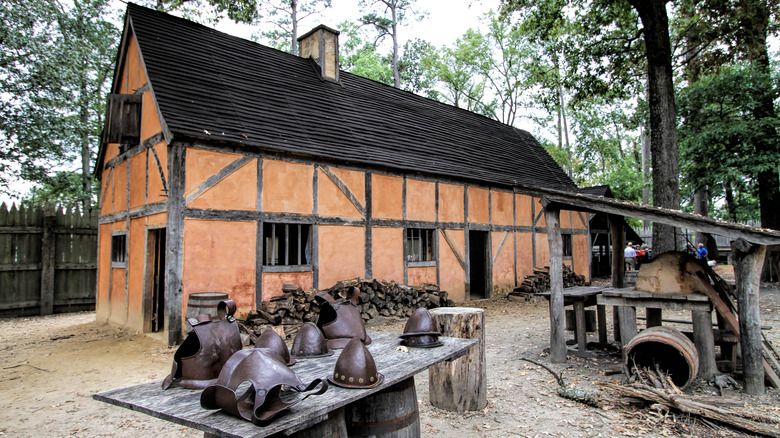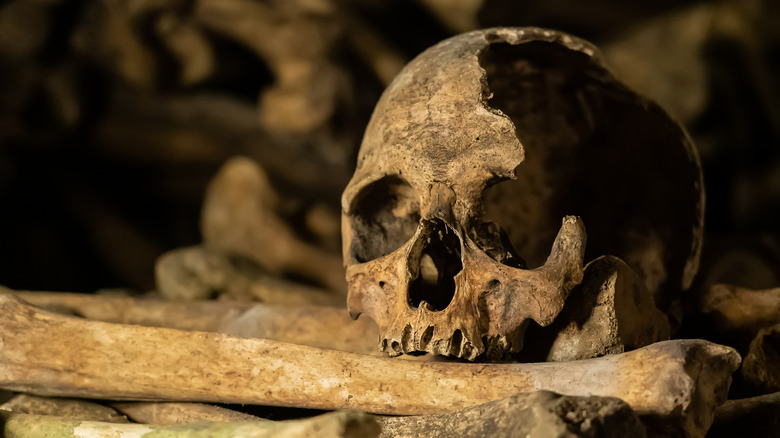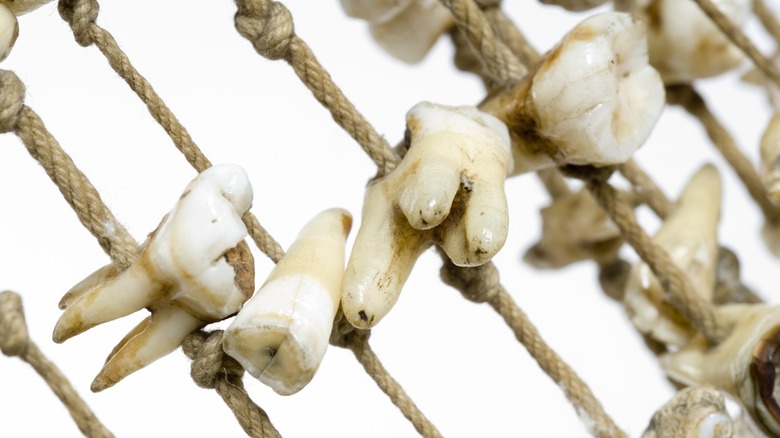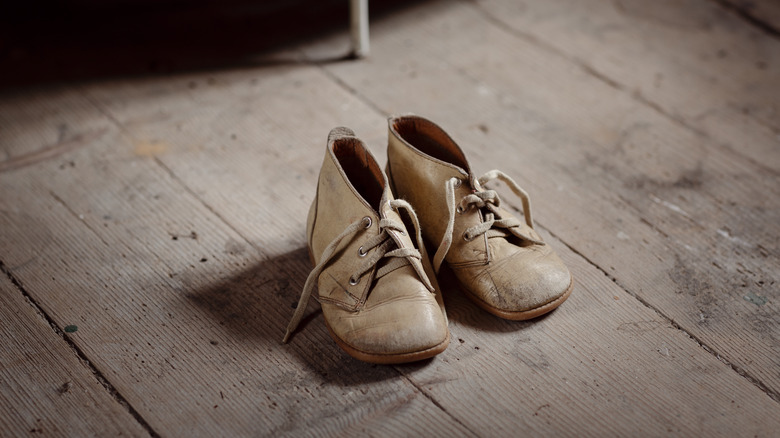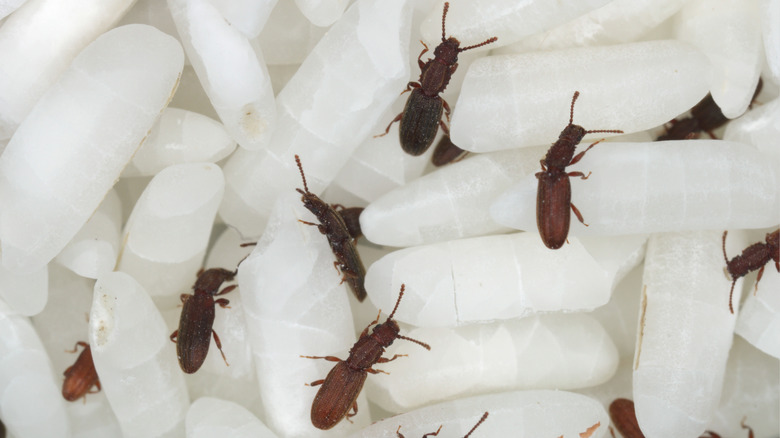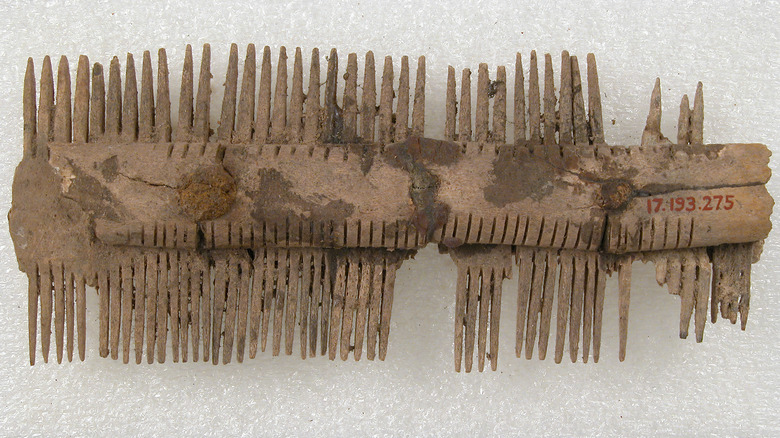The Creepiest Items Recovered From Jamestown
In 1607, 104 English men arrived in North America to start what would be the first permanent English settlement in the New World. Jamestown, Virginia, was chosen as the location for the settlement as it had the ideal environment for the arduous undertaking. The settlement was funded by the Virginia Company who also chose the council members who would lead the settlement, per National Park Service.
As might be expected, settling in a new land was by no means an easy task. The first 20 years the settlers struggled a great deal, even going through what was called the "Starving Time" that resulted in the small population of 500 dwindling down to 60 because of the harsh winter weather, food shortages, and attacks from the Powhatan tribe (via Historic Jamestowne). Nevertheless, Jamestown remained the center of activity until 1698 when the statehouse burned down and the seat of government was transferred to Williamsburg. A few settlers initially chose to remain, but by the mid-18th century, the Jamestown settlement was no more.
In 1994, the Jamestown Rediscovery project was established in order to uncover and study the artifacts left by settlers in the area. Over the years, more than 3 million artifacts have been excavated from the site, and they tell stories of what life was like in the first settlement in the New World.
The skull and bones of a cannibalized girl
In a 2012 dig in Jamestown, archeologists found the skull and bones of what was later confirmed to be that of a 14-year-old English girl's remains. Per Historic Jamestowne, the bones were found in a cellar together with other artifacts that date back to some of the earliest years of the settlement. What was noteworthy about the discovery aside from the age of the remains, was the young girl's skull had been smashed in two. Douglas Owsley, a forensic anthropologist who examined the bones, said that there was clear evidence of several strikes to the skull. "The chops to the forehead are very tentative, very incomplete. Then, the body was turned over, and there were four strikes to the back of the head," he said, according to Smithsonian Magazine. One of the blows was even strong enough to split the skull in two.
It is unknown whether the girl, whom archeologists call "Jane," died of natural causes or whether her death was murder. It was evident, however, that the girl was "dismembered for consumption." In a press conference, the discovery was called the first real evidence of the cannibalism that happened in Jamestown, most likely during the Starving Time when food was scarce and settlers were desperate to survive any way they could. Researchers also found cuts on the girl's forehead, jaw, and shinbones. Owsley thinks that the girl was not killed deliberately, but may have died in a natural way. Regarding the cannibalism, he said: "It's just that they were so desperate, and so hard-pressed, that out of necessity this is what they resorted to."
Teeth with cavities
Several teeth with cavities were also discovered at James Fort in Jamestown. The teeth seem to have fallen out by themselves as there were no markings on the teeth that would prove intentional extraction. Upon studying the teeth, researchers concluded that the person to whom the teeth belonged had suffered from advanced periodontal disease, per Historic Jamestowne. Periodontitis is a disease of the gums that is commonly the result of poor oral hygiene and is still commonplace today. The infection may cause the gums to bleed and swell, resulting in tooth loss. If not treated, per the Mayo Clinic, the teeth can loosen from the gums and may eventually fall out, which is most likely what happened with the teeth that were found in Jamestown.
When the first settlers arrived in Jamestown in 1607, there were two surgeons and a barber within the group. The surgeons were most likely the ones who took care of the settlers' teeth, as well as their overall health, but barbers were also given surgical responsibilities because of their know-how in using razors. Per Dusty Info, settlers used pumice, herbs, gunpowder, or borax to whiten their teeth, but the ingredients were caustic and damaged the enamel, leading to tooth decay and teeth falling out.
A child's leather shoe
In July 2006, the Jamestown Rediscovery archeology team made an exciting discovery when they recovered artifacts from the bottom of a 17th-century well. Among the items they found was a child's leather shoe that dates back to 1617. When settlers arrived in Jamestown in 1607, there were a few tradesmen who came along. While there's no confirmation a shoemaker was one of them, someone practicing the profession was most likely there as early as 1609, per Colonial Williamsburg. The well where the shoe was found eventually dried up and was filled with trash. It was covered up and the governor's house was built on top, leaving artifacts and items left buried for hundreds of years until the discovery in 2006.
According to Historic Jamestowne, the child's shoe was made of goat skin with a draw-bridge style that was popular in the 17th century. The shoe was found to be a size 1 and was only slightly worn most likely because its owner hasn't learned how to walk yet. The leather shoe is a rare find as not many artifacts were discovered related to children in Jamestown. In addition, there wasn't a supply of shoes in the early years of the settlement, making the child's shoe a special find.
400-year-old insect remains
One of the most exciting discoveries found in Jamestown were the remains of more than two dozen beetle species that originated from Europe. One of the species, the saw-toothed grain beetle, most likely infested grains and food supplies when ships traveled from Europe to Virginia. Researchers confirm that the insect remains date back hundreds of years, and even John Smith wrote about the pests saying that the storage "contained as many wormes as grains." In 1608, he wrote about the worm infestation in the colony's food supply, but because food was scarce, settlers had no choice but to eat them. "Al the provision of the store... was so rotten with... wormes, as the hogs would scarsely eat it, yet it was the souldiers diet" (via Historic Jamestowne).
The discovery of insect species also provided researchers a clearer picture of Jamestown's environment in the early 1600s. Other insects found included bed bugs, as well as the Trox scaber beetle that thrived on the food supplies and on the trip from England to Virginia.
Combs
In the 17th century, combs were unlike the ones used today. They were more extravagant and usually made of bone or ivory with intricate carvings. However, they weren't merely used for fixing the hair. Combs also had a hygienic purpose and were used for removing lice from hair or beards, per Atlas Obscura. In Jamestown, more than 40 combs have been discovered during archeological digs. Although the combs were made of bone, they weren't fancy at all. Most of the combs found were double-sided, with one side having smaller spaces between the teeth to comb away lice, and the other having wider spaces for grooming.
Since overall hygiene wasn't that great at the time of the first settlers, the combs were used to get rid of nits, fleas, and lice from hair. According to researchers, the combs found date back to 1607-1610 and were most likely brought by the initial settlers in Virginia.
